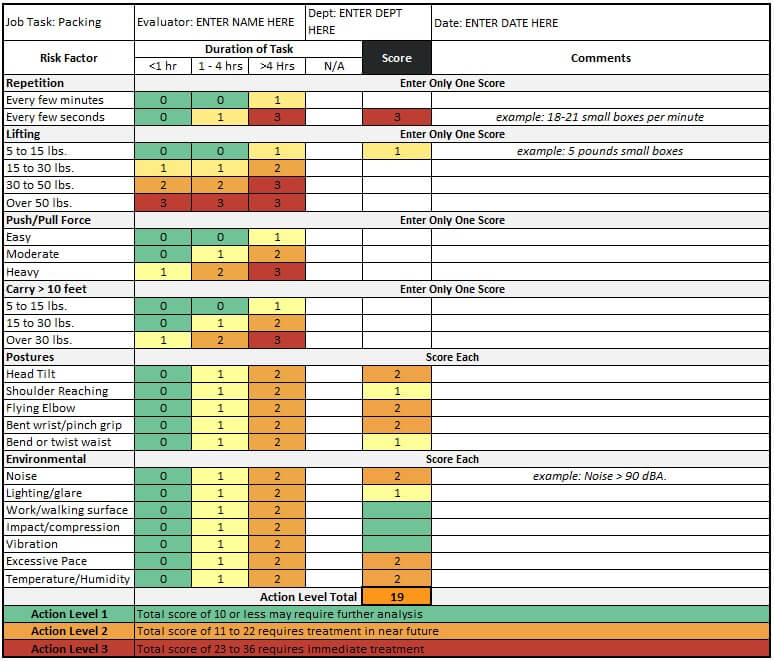Introduction
Ergonomic risk factors exist in almost every workplace, contributing to 33% of all disabling occupational incidents and 40% of the direct workers’ compensation costs annually (Liberty Mutual, 2019; Bureau of Labor Statistics, 2020). In addition to worker injuries, such risk factors negatively impact quality, production, service efficiency, employee morale, and overall operational success.
Organizations can reduce these risks by establishing an Ergonomics Risk Assessment and Management (ERAM) process to anticipate, recognize, evaluate, and minimize ergonomic risk factors that lead to these problems. Assessment tools such as the Ergonomics Risk Assessment Tool (ERAT), modified from the draft ANSI Z365 checklist highlighted in this best practice, can be used in this process.
The use of an ERAM process can be considered a best practice, and the ERAT tool provides an easy technique that can be used in many situations to achieve ergonomic-related improvements. The use of ERAT is described in the Applied Ergonomics Risk Assessment article published in SHIFT (Lyon, Popov, and Tinker, 2022) as part of a model for assessing and reducing workplace ergonomic risk factors. We share this flexible ergonomic risk assessment tool as one technique that can be easily used by safety practitioners and workers to assess ergonomic risk factors and improvement opportunities. In addition, application of this best practice is incorporated in BCSP’s CSP Blueprint concepts included in Domains 2 (management systems), 3 (risk management), 4 (advanced application of key safety concepts), and 6 (occupational health and ergonomics).
Ergonomic Risk Assessment Tools
There are many methods available for assessing ergonomic risk factors; most are targeted to a limited range or single type of application or body segment and require some degree of experience and training to use and apply properly. The ERAT is a relatively simple tool based on an ergonomics checklist that was part of a working draft document developed by the Management of Work-Related Musculoskeletal Disorders Accredited Standards Committee. The ERAT provides a standardized method for quickly identifying and assessing ergonomic risk factors for upper extremities in most work environments. This spreadsheet-based method has an initial assessment worksheet and a post-treatment assessment worksheet providing a ‘before and after’ comparison of the risk levels. It was developed as a result of working with organizations that needed a simplified means of identifying and controlling workplace ergonomic risks by frontline workers, supervisors, in-house engineers, and local management. Most assessors can use the ERAT successfully after minimal training in identifying, assessing, and scoring observable risk factors (repetition, lifting, pushing, pulling, carrying, postures, and environment).
Specifically, the ERAM model provides a defined, systematic way for stakeholders to:
- Identify existing jobs and tasks with ergonomic risk factors.
- Assess, prioritize, and track ergonomic risk factors in the workplace.
- Select and implement effective treatments to reduce ergonomic risk factors.
- Prevent new ergonomic risk factors from being introduced into the workplace.
- Support continual improvement as part of a safety management system.
As with any occupational safety and health (OSH) initiative, an ERAM process must be applied as a collaborative effort with full management commitment and active employee involvement to be effective.
This best practice example presented below is based on a simplified model.

Practical Application of ERAT Tool
In the following paragraphs, we describe how to use the ERAT tool to evaluate the process of manually packaging small boxes fed by a rolling conveyor into larger overpack boxes.
Problem Description
Supply Chain Risk Management (SCRM) is the process of identifying, assessing, and managing product and service risks within the supply chain. In order to deliver the products to the clients in good shape, they must be packaged properly. Manual packaging is a labor-intensive process presenting Musculoskeletal Disorder (MSD) risk. The readers are encouraged to watch the real-world packaging operation video.
Process Requiring Ergonomic Evaluation
The pictures below illustrate the sequence of packaging steps and ergonomic risk factors.
- The packer grips a small box weighing 5 pounds.
- The packer then picks up the small box.
- The packer uses proper techniques.
- The packer then fits the small box into a larger shipping box.
- The packer repeats the process 3 more times.

Step 1: Gripping box

Step 2: Lifting box

Step 3: Note raised elbow and shoulder abduction.

Step 4: Fitting boxes into shipping box
Conducting the Ergonomics Risk Assessment
First, the persons utilizing the ERAT tool must be trained in and aware of the ergonomic risk factors listed in the ERAT. See Fig. 2 below. The tool itself is simple and relatively intuitive to use.
Second, the evaluators then observe work (in this case, packing) in action. While doing so, they evaluate the presence or absence of ergonomic risk factors identified in the ERAT. These risk factors pertain to the nature and extent of repetitiveness of task, lifting, push and pull forces, carrying requirements, postures, and environmental factors. The assessors also talk with people conducting the work regarding how long work tasks are conducted. The risk factors are then paired with knowledge of how long the work tasks last to calculate risk scores and potential actions.
In this illustration, it was found that the line operators package the small boxes for eight (8) hours or more a day. Depending on the production schedule, the non-powered, flexible skate wheel conveyor line speed is manually controlled. Step 1 presents an example of the packer repetitively gripping the packages. The readers will also notice many other repetitive movements and awkward postures, including elevated elbow, shoulder abduction, head tilting, bent wrist and gripping, and upper body bending, flexing, and twisting. In addition, the work environment has excessive noise and extreme (high) temperatures. During the summer months, the temperature in the packaging facility often exceeds 100°F.
For this example, assessors completed the ERAT initial assessment form, as shown in Fig. 2 below.

Use: The ERAT is limited to the assessment of ergonomic risk factors impacting the upper extremities and is appropriate for office work, assembly, and process line work environments. The initial assessment (IA worksheet) is used to develop a baseline risk score and action level with possible control measures to reduce risk factor scores. It is suggested that videotape analysis be used to study task repetition, postures, lifts, pulls, pushes, carries, and other factors covered by the assessment tool.
Instructions: For each row that applies, score the task based on the duration and observed risk factor. Score one row per risk factor category in the first column (repetition, lift, push, pull, and carry > 10 ft). For ‘Postures’ and ‘Environment,’ score all rows that apply. For individual risk factor scores of 2 or more, treatments may be needed and briefly described in the ‘Comments’ section. Add the scores in the subtotal and total columns. If the total sum of ergonomic risk factors identified is equal to or greater than 10 (Action Level 1), it indicates the possible need for further treatment. If the total is between 11 and 22 (Action Level 2), it requires treatment in the near future. If the total exceeds 22 (Action Level 3), immediate treatment is required.
The initial assessment of this case study resulted in a score of 19, which is a high-end Action Level 2 (borderline Action Level 3) score requiring “immediate to near future” intervention. It is advisable that the organization establish a Prevention through Ergonomics (PtE) Risk Reduction Committee. The PtE team should consider recommending risk treatment measures that reduce the identified ergonomic risk factors. It is advisable to use the Hierarchy of Ergonomic Risk Treatments presented below.
| Method | Phase/Application | Examples | Effectiveness |
|---|---|---|---|
| Avoidance | Conceptual Stage – Design/Redesign | Prevent entry of hazard into workplace by design through selection of technology and work methods | High |
| Elimination | Existing Process – Redesign | Eliminate hazard by changes in design, equipment and methods | High |
| Substitution | Existing Process – Redesign | Substitute materials, sizes, weights and other aspects to a lower hazard severity or likelihood | Moderately High |
| Engineering Controls | Existing Process – Redesign | Reduce hazard by changes to workplace, tools, equipment, fixtures, adjustability, layout, lighting, work environment | Moderate |
| Administrative Controls | Existing Process – Practice and Procedures | Reduce exposure to hazard by changes in work practices, training, job enlargement, job rotation, rest breaks, work pace | Moderately Low |
| Personal Protective Equipment | Existing Process – Workers | Reduce impact of hazard to employee by use of protective equipment and materials such as vibration attenuation gloves | Low |
| Note. Adapted from “Improving Ergo IQ: A Practical Risk Assessment Model,” by B.K. Lyon, G. Popov and K. Hanes, 2013, Professional Safety, 58(12), 26-34. |
|||
By using the Hierarchy of Ergonomic Risk Treatments, the organization should perform a cost-benefit analysis and decide on intermediary solutions and long-term solutions. The organization may consider a powered conveyor system, design features (heights and distances), ergonomic mats, and other risk treatment alternatives.
The ultimate goal is to eliminate ergonomic risks by automation.
Risk Treatment Solutions
Since this example presents the case of an existing operation, avoidance of the ergonomic risk factors is not an option (the process already exists). However, it is possible to eliminate some existing ergonomic risk factors associated with the packing task. For instance, complete automation of the packing line could be considered to eliminate the exposure to repetitive manual handling risk factors. An example of an automated operation is presented below.
Post-Treatment Assessment
By comparing the ergonomic risk level before and after the implementation of the ergonomic risk treatments, a residual risk level and risk reduction percentage can be estimated and communicated with decision-makers to document workplace risk reduction improvements. Post-treatment ERAT risk level and risk reduction percentage estimation are presented in Fig. 4 below

Full automation of the packaging process will lead to elimination of manual repetition, lifting forces, and awkward body postures associated with manual handling of packages. However, the noise levels, insufficient lighting in the morning, and glare in the afternoon will receive the same rating. Excessive pace will be eliminated; however, the extreme temperatures will remain unchanged. It should be noted that when implementing any risk treatment, follow-up assessments should be made to identify and assess any new risks introduced to the process.
The proposed intervention reduced the ERAT score from 19 (Action level 2) to 5 (Action Level 1). This represents an estimated 74% risk reduction.
Benefits
- OSH Risk Reduction
- Improved productivity
- Financial benefits
- Better company reputation
Conclusion
Overall, the ERAT is relatively easy to use and includes the assessment of repetition, lifting, push and pull force, carrying, postures, and environmental ergonomic risk factors. This technical analysis demonstrates the importance of including environmental conditions in the ergonomic risk assessment. This best practice example can be implemented by organizations to train operators, supervisors, and production managers to promote ergonomics risk assessments and improve productivity.
↓ Download free ERAT tool here
Watch short instructional video:
Bibliography
Bureau of Labor Statistics. (2019) Occupational injuries and illnesses resulting in musculoskeletal disorders (MSDs). Retrieved July 25, 2022, at: https://www.bls.gov/iif/factsheets/msds.htm
Lyon, B.K. Popov, G. & Hanes, K. (2013, Dec). Improving Ergo IQ: A Practical Risk Assessment Model. Professional Safety, 58(12), 26-34.
Liberty Mutual Group. (2019). 2019 Workplace Safety Index: The top 10 causes of disabling injuries at work. Retrieved July 25, 2022 at: https://www.libertymutualgroup.com/about-lm/news/documents/2019-workplace-safety-index.pdf and https://business.libertymutual.com/insights/2019-workplace-safety-index-the-top-10-causes-of-disabling-injuries-at-work/

